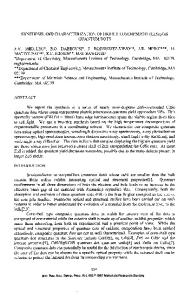Electrochemical characterization and biological applications of luminescent zirconia quantum dots
- PDF / 4,553,440 Bytes
- 11 Pages / 595.276 x 790.866 pts Page_size
- 18 Downloads / 324 Views
Electrochemical characterization and biological applications of luminescent zirconia quantum dots G. Deepthi Reddy1 · M. Noorjahan1 · A. Ratnamala2 · M. Haseena2 · H. Manjunatha2 · K. Chandra Babu Naidu3 Received: 29 May 2020 / Accepted: 23 August 2020 © Springer-Verlag GmbH Germany, part of Springer Nature 2020
Abstract Luminescent zirconia quantum dots (ZQDs) were prepared by wet leaf extract of Spinacia oleracea plant with varying ultrasonication treatment reaction time. The results of characterization studies on ZQDs revealed that particles are in monoclinic and tetragonal phase with the small spherical shape exhibiting blue–green and orange red emission properties. Electrochemical impedance and cyclic voltammetry studies were carried out, resulting in good electrocatalytic activity of ZQDs. Cellular mitochondrial activity was determined by MTT assay, anti-oxidant capability was determined using DPPH assay and in-vitro antibacterial activity studies were performed on Gram-negative E. coli bacteria and Gram-positive bacteria Bacillus subtilis for ZQDs. Biological studies on ZQDs revealed Ultrasonic 10 min (US-10) as a potential anti cancer agent against human cancer cell line (MCF-7) with an IC 50 value of 59.70 µg/mL, anti-oxidant agent with IC 50 value of 170 µg/mL and antibacterial agent showing good inhibition zones against E. coli and B. subtilis. Keywords Ultrasonication · Zirconia quantum dots · Electrochemical characterization · Antibacterial · Antioxidant · Cytotoxicity
1 Introduction Nano sized/engineered metal oxides have shown tremendous interest in field of optoelectronics, catalysis, sensors, solar cells, biomedical applications and so on due to their distinctive physical and chemical properties differing from the bulk [1–3]. Among all the metal oxides, zirconia nanomaterials have attracted more attention due to its versatile mechanical properties like high toughness and high tensile strength, corrosion and abrasion resistance. Apart from the mechanical properties ZrO2 shows low thermal conductivity, high thermal expansion coefficient, resistance to chemicals, refractoriness etc. They also exhibit super plasticity, * M. Noorjahan [email protected] * K. Chandra Babu Naidu [email protected] 1
Department of Chemistry, Palamuru University, Mahbubnagar, Telangana 509001, India
2
Department of Chemistry, GITAM University, Bengaluru Campus, Bangalore, Karnataka 562163, India
3
Department of Physics, GITAM Deemed to be University, Bangalore, Karnataka 562163, India
nontoxicity and oncological safety which make them useful in biomedical fields such as diagnostics, biosensing and bioelectronics [4, 5]. The size and shape of the nanoparticles greatly influence the bioactivity and luminescence properties of metal oxides. Nanocrystalline ZrO2 with desired size and morphologies have been effectively prepared by different synthesis methods like hydrothermal synthesis, sol–gel synthesis, co-precipitation, thermal decomposition, and solvothermal methods etc., [6–8]. All these methods ado
Data Loading...










